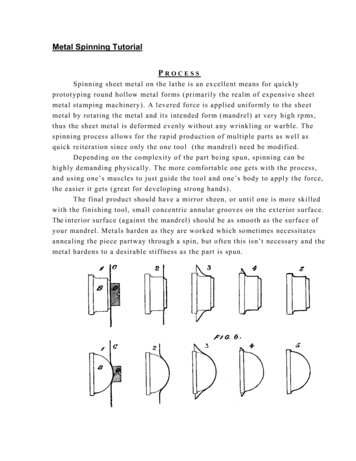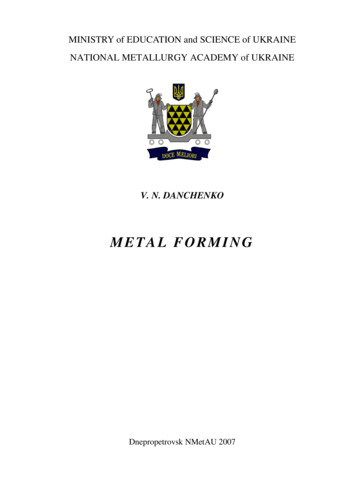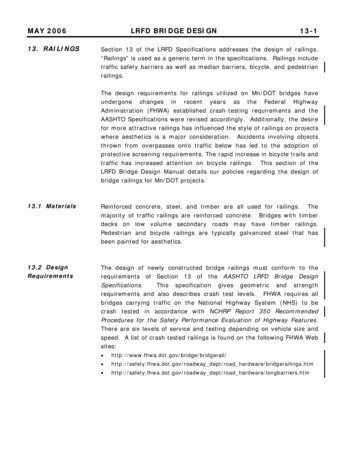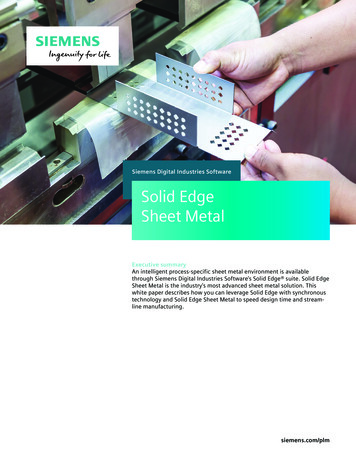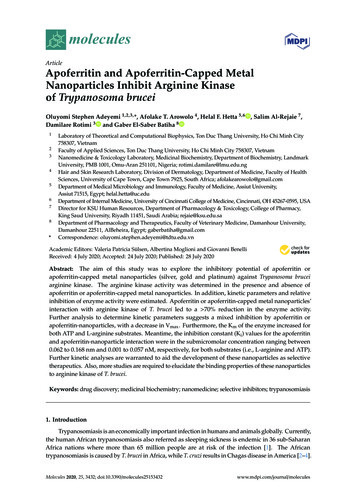
Transcription
moleculesArticleApoferritin and Apoferritin-Capped MetalNanoparticles Inhibit Arginine Kinaseof Trypanosoma bruceiOluyomi Stephen Adeyemi 1,2,3, *, Afolake T. Arowolo 4 , Helal F. Hetta 5,6 , Salim Al-Rejaie 7 ,Damilare Rotimi 3 and Gaber El-Saber Batiha 812345678*Laboratory of Theoretical and Computational Biophysics, Ton Duc Thang University, Ho Chi Minh City758307, VietnamFaculty of Applied Sciences, Ton Duc Thang University, Ho Chi Minh City 758307, VietnamNanomedicine & Toxicology Laboratory, Medicinal Biochemistry, Department of Biochemistry, LandmarkUniversity, PMB 1001, Omu-Aran 251101, Nigeria; rotimi.damilare@lmu.edu.ngHair and Skin Research Laboratory, Division of Dermatology, Department of Medicine, Faculty of HealthSciences, University of Cape Town, Cape Town 7925, South Africa; afolakearowolo@gmail.comDepartment of Medical Microbiology and Immunology, Faculty of Medicine, Assiut University,Assiut 71515, Egypt; helal.hetta@uc.eduDepartment of Internal Medicine, University of Cincinnati College of Medicine, Cincinnati, OH 45267-0595, USADirector for KSU Human Resources, Department of Pharmacology & Toxicology, College of Pharmacy,King Saud University, Riyadh 11451, Saudi Arabia; rejaie@ksu.edu.saDepartment of Pharmacology and Therapeutics, Faculty of Veterinary Medicine, Damanhour University,Damanhour 22511, AlBeheira, Egypt; gaberbatiha@gmail.comCorrespondence: oluyomi.stephen.adeyemi@tdtu.edu.vnAcademic Editors: Valeria Patricia Sülsen, Albertina Moglioni and Giovanni BenelliReceived: 4 July 2020; Accepted: 24 July 2020; Published: 28 July 2020 Abstract: The aim of this study was to explore the inhibitory potential of apoferritin orapoferritin-capped metal nanoparticles (silver, gold and platinum) against Trypanosoma bruceiarginine kinase. The arginine kinase activity was determined in the presence and absence ofapoferritin or apoferritin-capped metal nanoparticles. In addition, kinetic parameters and relativeinhibition of enzyme activity were estimated. Apoferritin or apoferritin-capped metal nanoparticles’interaction with arginine kinase of T. brucei led to a 70% reduction in the enzyme activity.Further analysis to determine kinetic parameters suggests a mixed inhibition by apoferritin orapoferritin-nanoparticles, with a decrease in Vmax . Furthermore, the Km of the enzyme increased forboth ATP and L-arginine substrates. Meantime, the inhibition constant (Ki ) values for the apoferritinand apoferritin-nanoparticle interaction were in the submicromolar concentration ranging between0.062 to 0.168 nm and 0.001 to 0.057 nM, respectively, for both substrates (i.e., L-arginine and ATP).Further kinetic analyses are warranted to aid the development of these nanoparticles as selectivetherapeutics. Also, more studies are required to elucidate the binding properties of these nanoparticlesto arginine kinase of T. brucei.Keywords: drug discovery; medicinal biochemistry; nanomedicine; selective inhibitors; trypanosomiasis1. IntroductionTrypanosomiasis is an economically important infection in humans and animals globally. Currently,the human African trypanosomiasis also referred as sleeping sickness is endemic in 36 sub-SaharanAfrica nations where more than 65 million people are at risk of the infection [1]. The Africantrypanosomiasis is caused by T. brucei in Africa, while T. cruzi results in Chagas disease in America [2–4].Molecules 2020, 25, 3432; molecules
Molecules 2020, 25, 34322 of 9On the other hand, a different type of trypanosomiasis (the African T. brucei brucei) affects animals and itis referred to as Nagana [1]. Currently, there is no effective therapy for trypanosomiasis [5–7]. Also, effortstoward the development of vaccine largely remain unsuccessful. The current treatments have severalchallenges, among which are toxic side effects, and poor effectiveness. Trypanosoma infection couldlead to fatal outcomes if left untreated [8]. Therefore, there is a need for novel treatment strategiesfor trypanosomiasis. Arginine kinase could be a potential drug target not only in trypanosomesbut also in the tsetse fly (the vector of disease infection and transmission) [9]. Arginine kinase is aphosphotransferase that reversibly catalyzes the formation of the phosphagen-phosphoarginine, fromL-arginine and ATP as substrates [10]. Phosphoarginine supports the burst of cellular activity untilmetabolic events like glycogenolysis, glycolysis and oxidative phosphorylation are activated [11–13].The phosphagens may act as a reservoir, not only of ATP but also of inorganic phosphate (pi)that is mostly returned to the medium by metabolic consumption of ATP [14,15]. Since there isno expression of arginine kinase in humans [16], arginine kinase serves as an attractive target fordeveloped trypanocides. In addition, studies have shown that inhibition of arginine kinase was lethalto the parasite growth and survival [15,16]. These findings support the importance of this enzyme tothe parasite survival in host cells. To this end, selective inhibitors of arginine kinase are welcome andmay become candidates for the early development of trypanocides.Previously, we reported that polyphenol-capped nanoparticles and gallotannin strongly inhibiteda recombinant form of arginine kinase [17–19]. Specifically, nanoparticles are of interest becauseof their small sizes as well as the large surface to area ratio. More so, we recently showed thatinorganic nanoparticles restricted the in vitro growth of various Trypanosoma species [20]. In addition,nanomaterials have continued to receive increasing consideration for diverse applications cuttingacross biology, biomedicines and the environmental science, among others [21]. In particular, goldnanoparticles in parasitology research are being investigated for detection techniques and drugdevelopment against parasitic infections. Apoferritin is a protein that usually functions to bind andstore iron. It does this by combining with a ferric hydroxide-phosphate compound to form ferritin.Apoferritin from horse spleen has a hollow cage-like structure, and this has been explored as a templatefor the synthesis of inorganic nanoparticles including silver, gold and platinum, among others [22].Ferritin-nanoparticles also hold prospects for biomedical applications [23]. Therefore, in the presentstudy, we explored apoferritin-capped nanoparticles for inhibitory potential against a recombinantarginine kinase of T. brucei.2. Results2.1. Apoferritin and Apoferritin-Capped Nanoparticles Reduced the Activity of Arginine Kinase of T. bruceiand Modulated Kinetic ParametersOur findings showed that apoferritin and apoferritin-nanoparticles caused an appreciabledecrease in the activity of arginine kinase of T. brucei compared with the control (Figures 1 and 2).The determination of the inhibition kinetic parameters following incubation of arginine kinase withthe apoferritin or apoferritin-nanoparticles was performed under two conditions. In the first condition,the L-arginine was used as a variable substrate at concentrations of 0.5–2.5 mM, and 0.5 mM ATP(Figure 1). In the second condition, the ATP concentration was varied (0.1–0.5 mM), with a fixed amountof the L-arginine at 2 mM (Figure 2). The apoferritin or apoferritin-nanoparticles concentrationsused in the assay were between 2.5 and 25 nM. Findings revealed that in the first condition inwhich L-arginine was varied at a fixed ATP concentration (0.5 mM), Vmax and Km, respectively, were0.169 µmol/min/mL and 0.021 mM. On the other hand, when ATP was varied, but at fixed L-arginineconcentration (2 mM), Vmax and Km were 0.170 µmol/min/mL and 0.005 mM, respectively (Table 1).Nonlinear regression analysis to determine kinetic parameters and mode of inhibition in the presenceof apoferritin and apoferritin-nanoparticles revealed that Vmax decreased while, the Km of the enzymeincreased only for the substrate L-arginine (Table 1). Similarly, Km of the enzyme for the substrateATP increased except for apoferritin-PtNPs wherein a decrease was recorded compared with the
Molecules 2020, 25, x8 of 9at fixed L-arginine concentration (2 mM), Vmax and Km were 0.170 μmol/min/mL and 0.005 mM,respectively (Table 1). Nonlinear regression analysis to determine kinetic parameters and mode ofinhibitionMolecules2020, in25, the3432 presence of apoferritin and apoferritin-nanoparticles revealed that Vmax decreased3 of 9while, the Km of the enzyme increased only for the substrate L-arginine (Table 1). Similarly, Km of theenzyme for the substrate ATP increased except for apoferritin-PtNPs wherein a decrease wascontrol.Together,the dataan uncompetitiveinhibitoryinteractionby the apoferritinandrecordedcomparedwith suggestthe control.Together, thedata suggestan bitoryinteractionsiinteraction by the apoferritin and apoferritin-nanoparticles.In addition, inhibition constants (Ki)wereinthesubmicromolarconcentration( 0.3nM)(Table1),suggestinga robust bindingaffinityvalues for these inhibitory interactions were in the submicromolar concentration( 0.3 iablesuggesting a robust binding affinity by the apoferritin and apoferritin-nanoparticles for leswereK0.057(apoferritin-silver),i valueskinase oftheT. brucei.WhenKATPwasforthethevariablesubstrate, the respectivei values for the apoferritin0.003(apoferritin-gold)and 0.002nm (apoferritin-platinum)nanoparticles. andHowever,L-argininenanoparticleswere 0.057(apoferritin-silver),0.003 (apoferritin-gold)0.002 whennM iplatinum) nanoparticles. However, when L-argininewas the variable substrate, the respectively(apoferritin-silver),0.160 (apoferritin-gold)and 0.1680.245(apoferritin-silver),nm (apoferritin-platinum).At the same time,values for the apoferritin-nanoparticleswere0.160 nd0.062nM,respectively,forATPandL-arginineas variablei0.245 nM (apoferritin-platinum). At the same time, apoferritin had Ki values of 0.001 and0.062 nM,substrates(Tablerespectively,for1).ATP and L-arginine as variable substrates (Table min)of Trypanosomabrucei argininekinaseFigure1. 1.Michaelis–Mentenplotsfor forthe theactivity(µmol/pi/min)of Trypanosomabrucei argininekinase wingincubationwith(A)apoferritin;(B)concentration of L-arginine was varied and following incubation with (A) apoferritin; (B) atinumnanoparticles.nanoparticles; (C) apoferritin-gold nanoparticles; (D) apoferritin-platinum nanoparticles. Data are anData areaverageof threereplicatestheplus/minusthe correspondingof mean (SEM).averageof anthreereplicatesplus/minuscorrespondingerror of meanerror(SEM).
Molecules 2020, 25, 3432Molecules 2020, 25, x4 of 98 of onof ATPwaswasvariedandandfollowingincubationwith with(A) apoferritin;(B) apoferritin-silverwhenconcentrationof ATPvariedfollowingincubation(A) apoferritin;(B) apoferritinnanoparticles;(C) apoferritin-goldnanoparticles;(D) apoferritin-platinumnanoparticles.Data areDataansilver nanoparticles;(C) apoferritin-goldnanoparticles;(D) apoferritin-platinumnanoparticles.averageof three replicatesplus/minusthe correspondingerror of mean(SEM).are an averageof three replicatesplus/minusthe correspondingerrorof mean (SEM).Table 1. Kinetic parameters estimated for the interaction between arginine kinase of Trypanosoma bruceiTable 1. Kinetic parameters estimated for the interaction between arginine kinase of Trypanosomaand apoferritin or apoferritin-nanoparticles.brucei and apoferritin or apoferritin-nanoparticles.* Vmax*(µmol/sec)Vmax(µmol/sec)Control Assay0.169 0.004Apoferritin0.012 0.001Apoferritin-AgNPs0.044 0.002ControlAssay 0.169 0.004Apoferritin-AuNPs0.067 0.006Apoferritin-PtNPs0.024 0.007** Vmax** Vmax(µmol/sec)(µmol/sec)0.170 0.0100.016 0.0010.034 0.0000.1700.0100.016 0.0010.030 0.001Km** Mean KiKm (L- Km (ATP)Km * Mean Ki(L-arginine)* Mean (nM)** Mean(mM)(nM)(mM)arginine)(ATP)Ki (nM)0.021 0.01(mM) 0.005 0.00(mM)0.041 0.000.015 0.000.062 0.010.005 0.168 0.030.0410.021 0.01 0.010.011 0.000.00 0.160 0.000.044 0.000.015 0.000.043 0.000.001 0.000.030.015 0.245 0.062Ki (nM)0.001 0.000.057 0.000.003 0.000.00 0.002 0.001 Apoferritin0.012 0.001 0.016 0.0010.041 0.00* L-arginine as a variable when ATP was fixed at 0.5 mM, while **ATP as a variable0.00substrate whileL-arginine was0.010.00fixed at 2 mM.Apoferritin0.011 0.168 0.057 0.044 0.002 0.034 0.0000.041 0.01AgNPs0.000.030.002.2. Apoferritin and Apoferritin-Capped Nanoparticles Caused Significant Decreases in the Relative ActivityApoferritin0.015 0.160 0.003 of Arginine Kinase of T.brucei0.067 0.006 0.016 0.0010.044 0.00AuNPs0.000.000.00The interactions of arginine kinase with either apoferritin or apoferritin-nanoparticlesled to aApoferritin0.001 0.245 0.0020.024 in 0.0070.030relative 0.001enzyme0.043 0.00compared with the control (Figures 3markedPtNPsreduction ( 70%)the averageactivity0.000.030.00and 4).* L-arginineWhen veactivityoftheenzymeas a variable when ATP was fixed at 0.5 mM, while **ATP as a variable substrate whilewas 35% comparedwiththe control.L-arginine was fixedat 2 mM. However, when ATP was the variable substrate, the average relativeactivity of the enzyme was 25% compared with the control. Overall, the data showed that the relativeactivityof arginineof T. brucei wasreduced byCausedan averageof 93%, 75%,in 90%and 73%for2.2. sSignificantDecreasesthe RelativeActivityapoferritin,of Arginineapoferritin-silver,Kinase of T. brucei apoferritin-gold and apoferritin-platinum nanoparticles, respectively.The interactions of arginine kinase with either apoferritin or apoferritin-nanoparticles led to amarked reduction ( 70%) in the average relative enzyme activity compared with the control (Figures3 and 4). When L-arginine was the variable substrate, the average relative activity of the enzyme was 35% compared with the control. However, when ATP was the variable substrate, the averagerelative activity of the enzyme was 25% compared with the control. Overall, the data showed thatthe relative activity of arginine kinase of T. brucei was reduced by an average of 93%, 75%, 90%
Molecules 2020, 25, x8 of 9Molecules2020,34325 of 9and 73%for25,apoferritin,apoferritin-silver, apoferritin-gold and apoferritin-platinum ivitywhenconcentrationof L-argininewasFigure 3.3. kinaserelativeactivitywhenconcentrationof L-argininevariedand andfollowingincubationwith with(A) (A)apoferritin;(B) ingincubationapoferritin;(B) noparticles;(D) apoferritin-platinumnanoparticles.Data areDataan averageof three(C)apoferritin-goldnanoparticles;(D) apoferritin-platinumnanoparticles.are an averagereplicatesplus/minusthe correspondingerror oferrormeanof(SEM)p 0.05significantversusof three replicatesplus/minusthe correspondingmeanwhile(SEM)atwhileat p* is0.05* is significantno inhibitor(0 nM).(0 nM).versusno inhibitorFigure4. Trypanosomakinase relativerelative activityactivity whenwhen thethe concentrationconcentration ofof L-arginineL-arginineFigure 4.Trypanosoma bruceibrucei argininearginine ritin;(B)apoferritin-silvernanoparticles;(C)was varied and following incubation with (A) apoferritin; (B) apoferritin-silver nsof(C) apoferritin-gold nanoparticles; (D) apoferritin-platinum nanoparticles at varied concentrations ofATP.DataDataareare anan averageaverage ofof threethree replicatesreplicates plus/minusplus/minus thethe correspondingcorresponding errorerror ofof meanmean (SEM)(SEM) whileATP.whileat 0.05at pp 0.05 ** isis significantsignificant versusversus nono inhibitorinhibitor (0(0 nM).nM).
Molecules 2020, 25, 34326 of 93. DiscussionSeveral investigations have shown that the arginine kinase of T. brucei could be a target forthe development of newer trypanocides [9,10,15–19,24,25]. The arginine kinase of T. brucei is anattractive drug target simply because it is not only critical to the survival of bloodstream forms ofthe parasite particularly under stressful conditions, but the enzyme is completely absent in humanhosts [16]. Therefore, the selective inhibition of arginine kinase of T. brucei may represent a viabletherapeutic option.In the present study, we explored the interactions between apoferritin-nanoparticles (Ag, Auand Pt) or apoferritin and a recombinant arginine kinase of T. brucei. Our findings indicate that theapoferritin-nanoparticles (Ag, Au and Pt) or apoferritin interacted with arginine kinase of T. bruceiin a way that appreciably decreased the enzyme activity. Apoferritin reduced the activity of thearginine kinase of T. brucei by 90% while the apoferritin-nanoparticles decreased the relative activityof the enzyme by 70%, confirming earlier reports [17–19]. Due to the small sizes of these particles,both apoferritin and apoferritin-nanoparticles may offer opportunities for the selective inhibition ofarginine kinase of T. brucei. Kinetic analysis revealed that the interactions between the Ag, Au and Ptapoferritin-nanoparticles or apoferritin were characteristic of mixed inhibition with a reduced Vmax inthe presence of the inhibitors compared with control. In addition, the small inhibition constant (Ki )values show a strong affinity of the apoferritin or apoferritin-nanoparticles for the arginine kinase ofT. brucei. Taken together, our present findings do not only conform to earlier reports which showed thatinorganic nanoparticles of gold, silver and platinum hold prospects as therapeutic inhibitors of T. bruceiarginine kinase in the fight against trypanosomiasis [17–19], but that these nanoparticles inhibitedTrypanosoma growth [20].Although the inhibition mechanism is yet unclear, previous reports have attributed the affinityand binding of these inorganic nanoparticles, notably Ag and Au particles, to the thiol (-SH) group ofcysteine residues in protein molecules as responsible for the change in conformation and eventualinhibition or activation of enzyme activity [20,22]. So, it may be that the apoferritin-nanoparticlesinteracted with the arginine kinase of T. brucei by binding a thiol group at such a position thatcompromises the required whole or active site structural conformation of the enzyme and thus, enzymeactivity. In a study by Pereira et al. [24,25], cysteine residues are part of the signature pattern ofthe guanidino kinases and these signature residues are conserved in the arginine kinase of T. bruceiamino acids.Our findings revealed inhibitory interactions between apoferritin-nanoparticles (Ag, Au andPt) or apoferritin and arginine kinase of T. brucei. Although data do not show for the first timethe inhibitory potential of apoferritin on arginine kinase of T. brucei, nonetheless, findings supportearlier reports that nanoparticles inhibit arginine kinase. Besides, the interactions were consistentwith mixed inhibition. In all, our findings warrant further analysis, including thermodynamic andin silico molecular docking studies. These studies could provide a molecular basis for the inhibitionof arginine kinase by apoferritin-nanoparticles or apoferritin. The insights of the binding propertiesare imperative to accomplish selective inhibition of the arginine kinase of T. brucei as well as for theeventual development of better trypanocides. In addition, it is worth noting that in the present study,the inhibitory concentrations of the nanoparticles are in the submicromolar range. This concentrationis well below the in vitro cytotoxic dose range ( 50–100 µg/mL) as reported elsewhere [26–30].Furthermore, we have previously reported that the oral LD50 for these nanoparticles (gold, platinumand silver) is 1000 mg/kg bw in rats [31–33]. Furthermore, even though nanomaterials includingmetal nanoparticles hold viable prospects for biomedical applications, a key challenge is the limitedunderstanding of how the particles interact with cellular materials.
Molecules 2020, 25, 34327 of 94. Materials and Methods4.1. ReagentsIn this work, T. brucei arginine kinase (recombinant form) and the apoferritin-nanoparticles(silver, gold and platinum) were obtained from the Nanomedicine and Biomedical Target Laboratory,Department of Biochemistry, Microbiology and Biotechnology, Rhodes University, South Africa.The biochemical characterization of arginine kinase is reported elsewhere [17,18], while the synthesis andcharacterization for the apoferritin-nanoparticles are described by Sennuga et al., [34,35]. All reagentswere products of Sigma, (St. Louis, MO, USA) and were of analytical grade.4.2. Determination of Protein Concentration and Activity of the Arginine Kinase of T. bruceiThe protein concentration was estimated by the Bradford method [36], while the enzymatic activityof T. brucei arginine kinase was confirmed as described elsewhere [17–19]. For the determination ofenzyme activity, the assay medium contained Tris-HCl buffer (100 mM, pH 8.6), L-arginine (2 mM),ATP disodium salt (0.5 mM), mercaptoethanol (10 mM), magnesium sulfate (200 mM) and 0.002 mmolof the enzyme. After incubation at 30 C for 5 min, 2.5% TCA (trichloroacetic acid) was added to stopthe reaction. After that, the reaction mixture was heated at 100 C in a heating block and cooled onice for 2 min. Inorganic phosphate (pi) determination reagent (fresh mixture of 9% ascorbic acid andacidic ammonium molybdate) was added to the reaction mixture, and the absorbance was recorded at700 nm on a microplate reader (Synergy Mx, Biotek Instruments, Inc. Winooski, VT, USA). The enzymewas absent in the control assay samples. The concentration of pi produced was extrapolated froma calibration curve of a standard. A unit of activity of the arginine kinase equals the amount of theenzyme that catalyzes the production of 1 µmol pi per minute.4.3. Assay to Determine Arginine Kinase Activity in the Presence of Apoferritin or Apoferritin-NanoparticlesThe arginine kinase activity in the presence of apoferritin or apoferritin-metal nanoparticles wasdetermined as described above. The inhibitory effect on the enzymatic activity of arginine kinaseof T. brucei was studied at varying concentrations (2.5 to 25 nM) of the apoferritin, apoferritin-metalcapped nanoparticles (silver, gold, and platinum nanoparticles).4.4. Data Presentation and Statistical AnalysisData were analyzed using the Michaelis–Menten plots and the nonlinear regression (GraphPadPrism 6.0, San Diego, CA, USA) analysis was used to determine the kinetic parameters and the Kivalues. Data are presented as mean of three replicates standard error of mean (SEM). In addition,comparisons of mean values relative to control were done using ANOVA and Dunnett’s post hoc test,while p 0.05 was taken as statistically significant.Author Contributions: Conceptualization, O.S.A. and A.T.A.; Data curation, O.S.A., H.F.H., and S.A.-R.; Formalanalysis, O.S.A., A.T.A., H.F.H., S.A.-R., D.R. and G.E.-S.B.; Investigation, O.S.A.; Methodology, O.S.A., D.R. andG.E.-S.B.; Resources, H.H. and S.A.-R.; Writing—original draft, O.S.A., A.T.A., D.R. and G.E.-S.B.; Writing—reviewand editing, O.S.A., A.T.A., H.F.H., S.A.-R., D.R. and G.E.-S.B. All authors have read and agreed to the publishedversion of the manuscript.Funding: This research received no external funding.Acknowledgments: Appreciation goes to Landmark University Nigeria and the Ton Duc Thang University,Ho Chi Minh City, Vietnam. Also, gratitude goes to the Nanomedicine and Biomedical Target Group at theDepartment of Biochemistry, Microbiology & Biotechnology, Rhodes University, South Africa. In addition, authorsextend their appreciation to the Researchers supporting Project Number (RSP-2020/ 120) King Saud University,Riyadh, Saudi Arabia.Conflicts of Interest: The authors declare no conflict of interest.
Molecules 2020, 25, 34328 of 17.18.19.20.World Health Organization (WHO). Trypanosomiasis, Human African (Sleeping Sickness). 2020.Available online: rypanosomiasis-human-african(sleeping-sickness) (accessed on 14 May 2020).Jarilla, B.R.; Agatsuma, T. Phosphagen Kinases of Parasites: Unexplored Chemotherapeutic Targets. Korean J.Parasitol. 2010, 48, 281–284. [CrossRef] [PubMed]Voncken, F.G.J.; Gao, F.; Wadforth, C.; Harley, M.; Colasante, C. The Phosphoarginine Energy-BufferingSystem of Trypanosoma brucei Involves Multiple Arginine Kinase Isoforms with Different Subcellular Locations.PLoS ONE 2013, 8, e65908. [CrossRef]Pereira, C.A.; Bouvier, L.A.; Cámara, M.D.L.M.; Miranda, M.R. Singular Features of Trypanosomatids’Phosphotransferases Involved in Cell Energy Management. Enzym. Res. 2011, 2011, 1–12. [CrossRef]Bachmaier, S.; Santos, Y.V.; Kramer, S.; Githure, G.B.; Klöckner, T.; Pepperl, J.; Baums, C.; Schenk, R.;Schwede, F.; Genieser, H.-G.; et al. Nucleoside analogue activators of cyclic AMP-independent protein kinaseA of Trypanosoma. Nat. Commun. 2019, 10, 1421. [CrossRef] [PubMed]Kulkarni, P.; Shah, N.; Waghela, B.; Pathak, C.; Pappachan, A. Leishmania donovani adenylate kinase 2aprevents ATP-mediated cell cytolysis in macrophages. Parasitol. Int. 2019, 72, 101929. [CrossRef]Thomas, S.M.; Purmal, A.; Pollastri, M.; Mensa-Wilmot, K. Discovery of a Carbazole-Derived Lead Drug forHuman African Trypanosomiasis. Sci. Rep. 2016, 6, 32083. [CrossRef] [PubMed]Holzmuller, P.; Geiger, A.; Nzoumbou-Boko, R.; Pissarra, J.; Hamrouni, S.; Rodrigues, V.; Dauchy, F.-A.;Lemesre, J.-L.; Vincendeau, P.; Bras-Gonçalves, R. Trypanosomatid Infections: How Do Parasites and TheirExcreted–Secreted Factors Modulate the Inducible Metabolism of l-Arginine in Macrophages? Front. Immunol.2018, 9, 778. [CrossRef]Ooi, C.-P.; Rotureau, B.; Gribaldo, S.; Georgikou, C.; Julkowska, D.; Blisnick, T.; Perrot, S.; Subota, I.; Bastin, P.The Flagellar Arginine Kinase in Trypanosoma brucei Is Important for Infection in Tsetse Flies. PLoS ONE 2015,10, e0133676. [CrossRef]Pereira, C.A. Arginine Kinase: A Potential Pharmacological Target in Trypanosomiasis. Infect. Disord. DrugTargets 2014, 14, 30–36. [CrossRef]Ellington, W.R. Evolution and Physiological Roles of Phosphagen Systems. Annu. Rev. Physiol. 2001, 63,289–325. [CrossRef]Chen, X.; Yao, P.; Chu, X.; Hao, L.; Guo, X.; Xu, B. Isolation of arginine kinase from Apis cerana cerana and itspossible involvement in response to adverse stress. Cell Stress Chap. 2014, 20, 169–183. [CrossRef]Fraga, D.; Aryal, M.; Hall, J.E.; Rae, E.; Snider, M.J. Characterization of the arginine kinase isoforms inCaenorhabditis elegans. Comp. Biochem. Physiol. Part. B Biochem. Mol. Boil. 2015, 187, 85–101. [CrossRef][PubMed]El Kouni, M.H. Pyrimidine metabolism in schistosomes: A comparison with other parasites and the searchfor potential chemotherapeutic targets. Comp. Biochem. Physiol. Part. B Biochem. Mol. Boil. 2017, 213, 55–80.[CrossRef] [PubMed]Pereira, C.A.; Alonso, G.D.; Ivaldi, S.; Silber, A.M.; Alves, M.J.M.; Torres, H.N.; Flawiá, M.M. Arginine kinaseoverexpression improves Trypanosoma cruzi survival capability. FEBS Lett. 2003, 554, 201–205. [CrossRef]Miranda, M.R.; Canepa, G.; Bouvier, L.A.; Pereira, C.A. Trypanosoma cruzi: Oxidative stress induces argininekinase expression. Exp. Parasitol. 2006, 114, 341–344. [CrossRef]Adeyemi, O.S.; Whiteley, C. Interaction of nanoparticles with arginine kinase from Trypanosoma brucei: Kineticand mechanistic evaluation. Int. J. Boil. Macromol. 2013, 62, 450–456. [CrossRef]Adeyemi, O.S.; Whiteley, C. Interaction of metal nanoparticles with recombinant arginine kinase fromTrypanosoma brucei: Thermodynamic and spectrofluorimetric evaluation. Biochim. Biophys. Acta (BBA) Gen.Subj. 2014, 1840, 701–706. [CrossRef]Adeyemi, O.S.; Sulaiman, A.F.; Iniaghe, O.M. Interaction between Gallotannin and a Recombinant Form ofArginine Kinase of Trypanosoma brucei: Thermodynamic and Spectrofluorimetric Evaluation. J. Biophys. 2014,2014, 675905. [CrossRef]Adeyemi, O.S.; Molefe, N.I.; Awakan, O.J.; Nwonuma, C.O.; Alejolowo, O.; Olaolu, T.; Maimako, R.F.;Suganuma, K.; Han, Y.; Kato, K. Metal nanoparticles show potential to restrict Trypanosoma growth. Artif.Cells Nanomed. Biotechnol. 2018, 46, S86–S94. [CrossRef]
Molecules 2020, 25, 6.9 of 9Benelli, G. Gold nanoparticles against parasites and insect vectors. Acta Trop. 2018, 178, 73–80. [CrossRef]Narayanaswamy, R.; Kanagesan, S.; Pandurangan, A.; Padmanabhan, P. Basics to different imaging techniques,different nanobiomaterials for image enhancement. Nanobiomat. Med. Imag. 2016, 8, 101–129. [CrossRef]Wang, Z.; Gao, H.; Zhang, Y.; Liu, G.; Niu, G.; Chen, X. Functional ferritin nanoparticles for biomedicalapplications. Front. Chem. Sci. Eng. 2017, 11, 633–646. [CrossRef]Bradford, M.M. A rapid and sensitive method for the quantitation of microgram quantities of protein utilizingthe principle of protein-dye bindin
Damilare Rotimi 3 and Gaber El-Saber Batiha 8 1 Laboratory of Theoretical and Computational Biophysics, Ton Duc Thang University, Ho Chi Minh City 758307, Vietnam . College of Pharmacy, King Saud University, Riyadh 11451, Saudi Arabia; rejaie@ksu.edu.sa 8 Department of Pharmacology and Therapeutics, Faculty of Veterinary Medicine, Damanhour .


